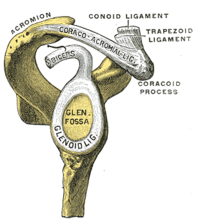
Photo from wikipedia
Background: Although the identification of patellar tendon rupture is a clinical diagnosis aided by standard radiography, magnetic resonance imaging (MRI) may aid in identifying the location of the rupture and… Click to show full abstract
Background: Although the identification of patellar tendon rupture is a clinical diagnosis aided by standard radiography, magnetic resonance imaging (MRI) may aid in identifying the location of the rupture and concomitant pathology. Purpose: To evaluate the characteristics of patellar tendon tears needing surgical repair and to determine whether patient or injury factors were predictive of tear location. Study Design: Case series; Level of evidence, 4. Methods: Consecutive patients who underwent primary patellar tendon repair for rupture between May 15, 2017, and April 10, 2020, were reviewed retrospectively. Exclusion criteria included age <18 years, surgical treatment of multiligamentous knee injury, laceration injury, and knee arthroplasty. Radiographs, MRI scans, MRI reports, clinic notes, and operative notes were evaluated. Statistical analysis was performed to determine factors associated with tear location, complications, and reoperation. Results: In total, 147 patients and 156 tendon tears were included; 82.1% of the tears were patellar avulsions, 14.7% were midsubstance or complex tears, and 3.2% were tibial avulsions. Patient and injury characteristics (body mass index, race, medical comorbidities, presence of patellar tendinitis, mechanism of injury, Insall-Salvati ratio, and the presence of infrapatellar bone fragments) were not predictive of tear location (P > .05). Patellar tendon ruptures were able to be clinically diagnosed correctly in >99% of cases. MRI was used to evaluate 77 (49.4%) knees. Patients who underwent MRI before surgery were more likely to have a history of preexisting tendinitis (P = .015) and a lower preoperative Insall-Salvati ratio (1.68 vs 1.52; P = .017). Conclusion: Patient and injury factors were not predictive of tear location. The majority of patellar tendon tears were avulsion-type injuries from the inferior patella. MRI was not necessary to aid in the diagnosis of patellar tendon rupture, as 99.4% of tears were able to be diagnosed clinically without advanced imaging.
Journal Title: Orthopaedic Journal of Sports Medicine
Year Published: 2023
Link to full text (if available)
Share on Social Media: Sign Up to like & get
recommendations!